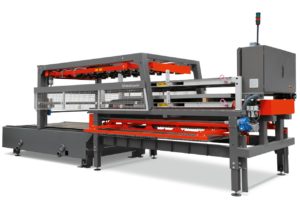 Speed and Consistency is the hallmark of today’s fiber laser cutting machinery and their capacity to process a vast amount of sheet metal on a daily basis. In order to maintain this consistent pace of production it is critical to have some form of material automation. While operators can be very efficient at the loading and unloading process, eventually there will be situations where the machine will not have the required raw material in a timely manner. This may be due to a variety of factors such as breaks, lavatory time, meal time, shift changes, meetings, and possibly at some point, operator fatigue. Automating the material load and unload cycles is key to maintaining the productivity capability of today’s fiber laser cutting machine.
Speed and Consistency is the hallmark of today’s fiber laser cutting machinery and their capacity to process a vast amount of sheet metal on a daily basis. In order to maintain this consistent pace of production it is critical to have some form of material automation. While operators can be very efficient at the loading and unloading process, eventually there will be situations where the machine will not have the required raw material in a timely manner. This may be due to a variety of factors such as breaks, lavatory time, meal time, shift changes, meetings, and possibly at some point, operator fatigue. Automating the material load and unload cycles is key to maintaining the productivity capability of today’s fiber laser cutting machine.
If you were to ask the operator of a fiber laser cutter who also previously operated a CO2 laser cutter how different operating one is from the other one answer will likely center around the considerably faster cutting capability of the fiber laser. You are effectively processing two to three times more volume of raw and cut material per unit of time. A CO2 operator, after unloading the cut material and loading a new raw sheet, typically had time to complete other tasks such as retrieving the next pallet of material for processing or moving finished cut parts to the next process. A fiber laser operator, on the other hand, is very limited in the amount of available time between the load and unload process and the need to attend to a new cut sheet from the fiber laser. It is with this fast pace that physical fatigue will eventually set in, plus any time spent away from the machine, for factors previously mentioned, will impact the ability to maintain a consistent pace for the fiber laser.
Automating the load and unload cycles is the most effective means of maintaining the production capabilities of the fiber laser cutter. With material automation in place, machinery operators can now return to completing the tasks that they previously attended to — preparing the next pallet of material, moving cut parts to the next operation and other tasks related to maintaining the overall pace of production.
When considering automation it is important to make sure that the total cycle time of the automation is no longer than the shortest sheet time, as the automation will now begin to pace the machine. Typically a total automation cycle time of around one minute is ideal to account for all future production requirements.
By Frank Arteaga, Head of Product Marketing, NAFTA Region
Bystronic Inc., Elgin, IL – Voice.bystronic@bystronic.com
